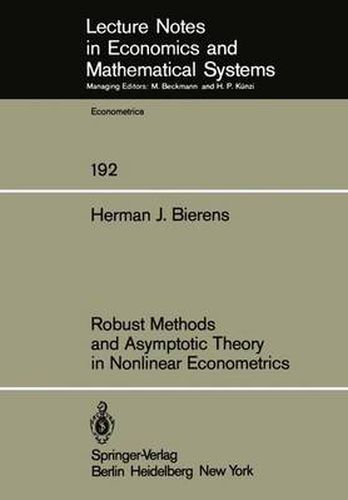Readings Newsletter
Become a Readings Member to make your shopping experience even easier.
Sign in or sign up for free!
You’re not far away from qualifying for FREE standard shipping within Australia
You’ve qualified for FREE standard shipping within Australia
The cart is loading…






This title is printed to order. This book may have been self-published. If so, we cannot guarantee the quality of the content. In the main most books will have gone through the editing process however some may not. We therefore suggest that you be aware of this before ordering this book. If in doubt check either the author or publisher’s details as we are unable to accept any returns unless they are faulty. Please contact us if you have any questions.
This Lecture Note deals with asymptotic properties, i.e. weak and strong consistency and asymptotic normality, of parameter estimators of nonlinear regression models and nonlinear structural equations under various assumptions on the distribution of the data. The estimation methods involved are nonlinear least squares estimation (NLLSE), nonlinear robust M-estimation (NLRME) and non linear weighted robust M-estimation (NLWRME) for the regression case and nonlinear two-stage least squares estimation (NL2SLSE) and a new method called minimum information estimation (MIE) for the case of structural equations. The asymptotic properties of the NLLSE and the two robust M-estimation methods are derived from further elaborations of results of Jennrich. Special attention is payed to the comparison of the asymptotic efficiency of NLLSE and NLRME. It is shown that if the tails of the error distribution are fatter than those of the normal distribution NLRME is more efficient than NLLSE. The NLWRME method is appropriate if the distributions of both the errors and the regressors have fat tails. This study also improves and extends the NL2SLSE theory of Amemiya. The method involved is a variant of the instrumental variables method, requiring at least as many instrumental variables as parameters to be estimated. The new MIE method requires less instrumental variables. Asymptotic normality can be derived by employing only one instrumental variable and consistency can even be proved with out using any instrumental variables at all.
$9.00 standard shipping within Australia
FREE standard shipping within Australia for orders over $100.00
Express & International shipping calculated at checkout
This title is printed to order. This book may have been self-published. If so, we cannot guarantee the quality of the content. In the main most books will have gone through the editing process however some may not. We therefore suggest that you be aware of this before ordering this book. If in doubt check either the author or publisher’s details as we are unable to accept any returns unless they are faulty. Please contact us if you have any questions.
This Lecture Note deals with asymptotic properties, i.e. weak and strong consistency and asymptotic normality, of parameter estimators of nonlinear regression models and nonlinear structural equations under various assumptions on the distribution of the data. The estimation methods involved are nonlinear least squares estimation (NLLSE), nonlinear robust M-estimation (NLRME) and non linear weighted robust M-estimation (NLWRME) for the regression case and nonlinear two-stage least squares estimation (NL2SLSE) and a new method called minimum information estimation (MIE) for the case of structural equations. The asymptotic properties of the NLLSE and the two robust M-estimation methods are derived from further elaborations of results of Jennrich. Special attention is payed to the comparison of the asymptotic efficiency of NLLSE and NLRME. It is shown that if the tails of the error distribution are fatter than those of the normal distribution NLRME is more efficient than NLLSE. The NLWRME method is appropriate if the distributions of both the errors and the regressors have fat tails. This study also improves and extends the NL2SLSE theory of Amemiya. The method involved is a variant of the instrumental variables method, requiring at least as many instrumental variables as parameters to be estimated. The new MIE method requires less instrumental variables. Asymptotic normality can be derived by employing only one instrumental variable and consistency can even be proved with out using any instrumental variables at all.